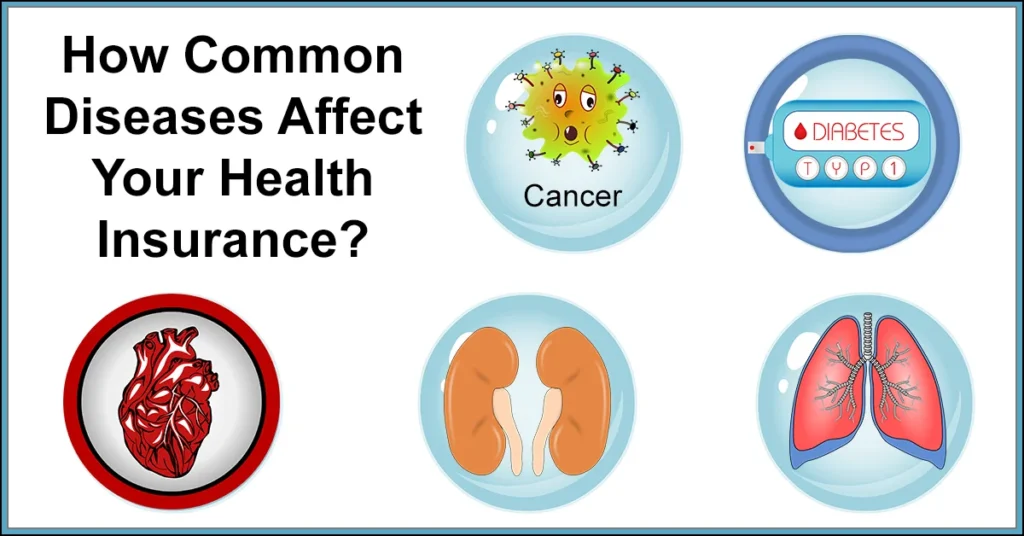How Common Diseases Affect Your Health Insurance?
What's inside?
- 1 How Common Diseases Affect Your Health Insurance?
- 1.1 Need for a Critical Illness Policy to Deal with a Chronic Condition
- 1.2 What are Chronic Diseases?
- 1.2.1 Does Health Insurance Cover Chronic Illnesses?
- 1.2.2 Chronic Conditions & Health Insurance Plans
- 1.2.3 Health Insurance Considerations for Chronic Illnesses
- 1.2.4 How to Get the Most Out of Your Health Insurance if You Have a Chronic Condition?
- 1.2.5 Managing Medication Costs with Health Insurance
- 1.3 Common Diseases Affecting People
- 1.3.1 Top Ten Lifestyle Diseases Afflicting Indian Population:
- 1.3.2 List of General Diseases and Consequences in India:
- 1.3.3 Major Diseases That Can Lead to Death:
- 1.3.4 Diseases Covered by Health Insurance
- 1.3.5 List of Diseases Not Covered by Health Insurance Generally
- 1.3.6 List of Pre-existing Diseases Covered by Health Insurance Generally
- 1.4 The Take of Insurance Companies on the Most Common Diseases
Health insurance is a type of insurance coverage that helps individuals and families pay for medical expenses. It provides financial protection against the high costs associated with healthcare services, such as doctor visits, hospitalizations, surgeries, and prescription medications. Health insurance policies are typically offered by employers, government programs, or purchased directly from insurance companies.
Need for a Critical Illness Policy to Deal with a Chronic Condition
For chronic conditions like heart disease, kidney failure, or cancer, a regular health insurance plan may not be enough. Critical illness policies provide a lump-sum payment upon diagnosis, allowing you to cover expensive treatments, hospitalization costs, or even loss of income during recovery. Having this additional policy can significantly ease financial stress when dealing with severe chronic conditions.
What are Chronic Diseases?
Chronic diseases are long-term health conditions that progress slowly over time and often persist throughout a person’s life. Unlike acute diseases, which come on suddenly and can be cured, chronic diseases may not have a permanent cure but can be managed with ongoing care. Common examples include diabetes, hypertension, heart disease, and arthritis. These conditions can significantly impact quality of life and often require continuous medical treatment, including medication, frequent doctor visits, and lifestyle changes.
In India, chronic diseases have been on the rise due to several factors, including unhealthy diets, lack of physical activity, stress, and environmental factors. These conditions can affect anyone, from the elderly to the young, which makes understanding their impact and planning ahead- especially in terms of health insurance- crucial for every individual.
Does Health Insurance Cover Chronic Illnesses?
Yes, many health insurance policies in India cover chronic illnesses, but the extent of coverage varies. Most insurance companies offer plans that include coverage for common chronic conditions like diabetes and hypertension. However, these are often subject to waiting periods and specific terms and conditions.
Pre-existing Diseases Clause: If you already have a chronic illness when buying a policy, it may be classified as a “pre-existing condition.” In such cases, there is usually a waiting period (often 2-4 years) before you can claim coverage for treatment related to that condition. However, some policies now come with shorter waiting periods or offer add-on riders for pre-existing diseases.
Critical Illness Plans: Specialized critical illness policies are available that cover diseases like cancer, heart disease, and kidney failure. These plans offer lump sum payments upon diagnosis, which can help you manage the high treatment costs associated with such severe conditions.
Chronic Conditions & Health Insurance Plans
Chronic conditions, while manageable, pose long-term healthcare challenges that require a solid health insurance policy. Insurers are now tailoring policies to provide better support, including options for coverage of OPD, regular check-ups, and critical illness add-ons. Understanding your condition and choosing a policy with the right benefits is key to ensuring financial protection.
Having a chronic illness significantly influences your health insurance. Here’s how:
- Higher Premiums: Insurers often charge higher premiums for individuals with chronic diseases because they are seen as higher risk.
- Waiting Periods: As mentioned, there is typically a waiting period for pre-existing conditions. During this time, treatment related to your illness may not be covered.
- Exclusions and Riders: Some insurers may exclude certain treatments or offer coverage through riders, which require additional premiums.
- Limited Coverage for OPD: While chronic conditions often require regular outpatient treatments, not all policies cover OPD (Outpatient Department) expenses like doctor consultations, diagnostic tests, or medications. Therefore, selecting a plan with OPD coverage is essential for those managing chronic diseases.
Health Insurance Considerations for Chronic Illnesses
When choosing health insurance for chronic illnesses, there are a few things to consider:
- Comprehensive Coverage: Opt for policies that offer comprehensive coverage, including hospitalization, OPD expenses, and diagnostics. This is important because chronic illnesses often require continuous treatment.
- No Claim Bonus: Many insurers in India offer a “No Claim Bonus” (NCB), which increases the sum insured if no claims are made during the policy year. This can benefit you in the long run, especially with chronic conditions where future healthcare costs may increase.
- Daycare Procedures: Some policies cover daycare procedures that don’t require 24-hour hospitalization, such as dialysis or chemotherapy, which are common for chronic illness management.
How to Get the Most Out of Your Health Insurance if You Have a Chronic Condition?
- Choose a Plan with OPD Coverage: Chronic conditions require regular doctor visits and tests. OPD coverage can help reduce the burden of these recurring expenses.
- Monitor Network Hospitals: Always ensure that your preferred hospitals are in the insurer’s network. This is crucial for cashless hospitalization, which can significantly ease the financial stress during treatment.
- Understand the Claim Process: For individuals with chronic conditions, a smooth claim process is critical. Choose insurers known for efficient claim settlements.
- Regular Health Checkups: Some policies offer free annual checkups, which can help in the early detection and management of chronic illnesses.
Managing Medication Costs with Health Insurance
Medication costs for chronic conditions can be high, but health insurance can help alleviate some of that financial burden.
- OPD Riders: As mentioned earlier, choosing a policy with an OPD rider helps cover expenses related to medicines.
- Pharmacy Discounts: Many health insurers now partner with pharmacies to offer discounts on medications for their policyholders, a benefit worth exploring.
- Daycare Procedures Coverage: If medications are part of treatments like chemotherapy or dialysis, ensure your plan covers such procedures.
Common Diseases Affecting People
Top Ten Lifestyle Diseases Afflicting Indian Population:
- Diabetes
- Hypertension
- Cardiovascular Diseases
- Obesity
- Stroke
- Chronic Respiratory Diseases
- Cancer
- Osteoarthritis
- Chronic Kidney Disease
- Liver Diseases (including fatty liver and cirrhosis)
These lifestyle diseases stem from sedentary habits, unhealthy diets, and stress- major contributors to India’s growing health crisis.
List of General Diseases and Consequences in India:
- Tuberculosis: A serious infectious disease, still prevalent in India.
- Dengue: A common mosquito-borne disease.
- Malaria: Another mosquito-borne illness, especially in rural areas.
- Typhoid: Often spread through contaminated food and water.
The consequences of these diseases can be severe, leading to loss of productivity, high medical costs, and even death if untreated.
Major Diseases That Can Lead to Death:
- Heart disease
- Cancer
- Chronic respiratory diseases
- Stroke
- Kidney failure
These diseases are the leading causes of death in India and often require long-term, expensive treatments.
Diseases Covered by Health Insurance
- Diabetes (after a waiting period)
- Hypertension
- Cardiovascular diseases
- Asthma
- Kidney disease (in some plans)
- Cancer (with critical illness cover)
List of Diseases Not Covered by Health Insurance Generally
- Cosmetic surgeries or treatments
- Infertility treatments
- Congenital diseases (in many policies)
- Obesity treatments
- Injuries caused by substance abuse
- Sexually transmitted diseases like HIV/AIDS
List of Pre-existing Diseases Covered by Health Insurance Generally
- Diabetes
- Hypertension
- Thyroid disorders
- Asthma
- Cardiac conditions
- High cholesterol (after waiting periods)
It’s important to disclose pre-existing conditions upfront when buying a policy to avoid claim rejections later.
The Take of Insurance Companies on the Most Common Diseases
Insurance companies assess the risks of various diseases to set coverage and premium rates. For conditions like cancer, heart disease, and lung diseases, they consider factors such as the stage, treatment, and likelihood of complications. Pre-existing conditions or a family history can result in higher premiums or coverage exclusions.
For chronic illnesses like diabetes and kidney disease, insurers focus on how well the condition is managed, as proper management reduces the risk of costly complications. Insurers also adjust policies based on medical advancements. To minimize the impact on insurance costs, it’s crucial to understand coverage, communicate with insurers, and follow treatment plans.
FAQs
Q. What does the waiting period of an Insurance policy mean?
The waiting period is the time during which certain claims cannot be made after purchasing a health insurance policy. For example, if your policy has a 2-year waiting period for pre-existing conditions, you cannot claim coverage for treatment related to that condition until the 2 years are over.
Q. Are pre-existing diseases totally excluded from health insurance policy coverage?
No, pre-existing diseases are not always excluded but are subject to a waiting period. Most health insurance policies will cover pre-existing diseases after a waiting period, typically ranging from 2 to 4 years, depending on the insurer and the policy.
Q. Is there any way of reducing the waiting period for pre-existing illnesses?
Yes, some insurers offer the option to reduce the waiting period by paying an additional premium or opting for policies with shorter waiting periods for pre-existing conditions. It’s essential to compare different policies to find the best option for your needs.
Q. Does pre-existing disease affect the amount of coverage?
Yes, having a pre-existing disease can affect your coverage. Insurers may charge higher premiums, impose a longer waiting period, or limit the coverage amount for treatments related to pre-existing conditions. In some cases, certain treatments may also be excluded.
Q. What is PED in Insurance?
PED stands for “Pre-Existing Disease”. It refers to any medical condition or illness that an individual has been diagnosed with or treated for before purchasing the health insurance policy. Insurers typically define pre-existing diseases and apply waiting periods for coverage.
Q. How does a pre-existing disease affect health insurance?
A pre-existing disease can impact your health insurance in several ways:
- Longer waiting periods for coverage
- Higher premiums
- Some conditions or treatments may be excluded
- Stricter terms and conditions for claim approval
Q. What are the diseases covered in health insurance?
Most health insurance policies in India cover common diseases such as:
- Diabetes (after the waiting period)
- Hypertension
- Heart diseases
- Cancer (usually under critical illness cover)
- Asthma
- Chronic kidney disease
It’s essential to check your specific policy for details on coverage.
Q. What do I do if I’m hurt and don’t have insurance?
If you don’t have insurance and need medical care, you can:
- Seek treatment at a government hospital where costs are usually lower.
- Explore charitable or community healthcare programs that offer affordable or free medical services.
- Negotiate with hospitals for a payment plan if private treatment is necessary.
Q. Can I claim insurance for typhoid?
Yes, most health insurance policies in India cover hospitalization and treatment for typhoid, provided you are past the initial waiting period for the policy. Check your policy to ensure that it includes coverage for infectious diseases like typhoid.
Q. How do insurance companies check for pre-existing conditions?
Insurance companies often request medical history records, ask for declarations of existing conditions, and may even require a pre-policy medical examination to identify pre-existing conditions before issuing a policy.
Q. Does HDFC Ergo cover pre-existing diseases?
Yes, HDFC Ergo covers pre-existing diseases, but like most insurers, they impose a waiting period before claims related to pre-existing conditions can be made. The waiting period usually ranges from 2 to 4 years, depending on the specific policy.
Q. Which disease is not covered in term insurance?
Term insurance typically does not cover critical illnesses or diseases unless you opt for a critical illness rider. Additionally, certain diseases caused by self-harm, substance abuse, or pre-existing conditions not disclosed during policy purchase may not be covered.
Q. What if pre-existing conditions are not declared?
If you do not declare pre-existing conditions when purchasing health insurance, the insurer may reject your claims or even cancel your policy when they discover the undisclosed condition. It is important to be honest and transparent during the application process.
Q. Is BP considered a pre-existing disease?
Yes, high blood pressure (BP) or hypertension is considered a pre-existing disease if diagnosed before purchasing a health insurance policy. It will likely be subject to a waiting period before related treatments are covered.
Q. Which treatment is not covered under Mediclaim policy?
Common exclusions under Mediclaim policies include:
- Cosmetic or plastic surgery (unless medically necessary)
- Infertility treatments
- Obesity treatment or weight loss surgery
- Treatments for injuries caused by substance abuse
- Experimental or alternative therapies
Q. Is snake bite covered by insurance?
Yes, treatment for a snake bite is generally covered under health insurance if it requires hospitalization. However, it is important to ensure that your policy covers accidental emergencies and hospitalization costs.
Q. What is any one illness in insurance?
“Any one illness” refers to a single continuous illness episode that begins with the first diagnosis and ends when treatment is no longer required. For insurance purposes, a relapse within 45 days of discharge is usually considered part of the same illness.
Q. Which disease is not covered in Care Health Insurance?
While Care Health Insurance covers a wide range of diseases, certain conditions like cosmetic treatments, fertility treatments, and diseases arising from substance abuse are typically excluded. Always check the policy terms for specific exclusions.
Q. What if I get illness after taking the health insurance policy?
If you develop a disease after purchasing health insurance, it will usually be covered under your policy, provided it falls within the covered conditions and is not excluded under the policy terms.
Q. Which health insurance company denies the most claims?
It’s hard to pinpoint a specific company that denies the most claims, as denial rates can vary year to year based on several factors like the policyholder’s health conditions and claim types. However, claim rejections are often due to insufficient documentation, undisclosed pre-existing conditions, or claims filed during the waiting period. It’s essential to review an insurer’s claim settlement ratio (CSR) before choosing a policy. A higher CSR means the company settles more claims.
Q. Is chronic disease covered in health insurance?
Yes, most health insurance policies cover chronic diseases like diabetes, hypertension, and asthma, but often after a waiting period. Additionally, some policies offer specific chronic care add-ons, and critical illness plans cover severe chronic diseases like heart disease, cancer, and kidney failure.
Q. What is considered a chronic illness for life insurance?
For life insurance, a chronic illness is typically defined as a long-lasting health condition that requires ongoing medical attention and impairs daily functioning. Examples include diabetes, cancer, cardiovascular diseases, and chronic respiratory diseases. These illnesses may affect the cost of premiums and eligibility for certain policies.
Q. What illnesses are considered chronic illnesses?
Common chronic illnesses include:
- Diabetes
- Hypertension
- Asthma
- Heart disease
- Cancer
- Chronic obstructive pulmonary disease (COPD)
- Arthritis
- Kidney disease
These conditions require long-term management and often have no permanent cure.
Q. What is the criteria for chronically ill?
A person is considered chronically ill if they have a disease or condition that lasts for an extended period, typically longer than 6 months, and requires continuous medical care or lifestyle management. These conditions usually impede daily activities and require regular monitoring or treatment.
Q. Which disease is not covered in health insurance?
Certain diseases and treatments are often excluded from health insurance policies. These include:
- Cosmetic surgeries
- Infertility treatments
- HIV/AIDS (in many policies)
- Obesity treatments
- Injuries due to self-harm or substance abuse
It’s important to check your policy’s exclusions carefully before purchasing.
Q. hat does chronic mean in insurance?
In insurance, “chronic” refers to long-term health conditions that require ongoing treatment and management over an extended period. These conditions generally do not have a cure and include illnesses like diabetes, hypertension, and arthritis.
Q. What are the permanently excluded diseases?
Permanently excluded diseases vary between insurers but commonly include:
- HIV/AIDS
- Congenital diseases (in many cases)
- Cosmetic and plastic surgeries
- Treatments related to drug or alcohol abuse
- Certain mental health conditions
Some policies also exclude critical illnesses that are diagnosed before purchasing the policy.
Q. Which disease is not covered in term insurance?
Term insurance primarily covers death and does not cover specific diseases. However, most term insurance policies do not cover deaths due to suicide within the first year of the policy. Additionally, pre-existing diseases are not directly covered unless the policyholder dies as a result of the disease.
Q. Which three illnesses are covered under most critical illness policies?
Most critical illness policies cover a wide range of diseases, but the most commonly included are:
- Cancer
- Heart Attack (Myocardial Infarction)
- Stroke
These conditions are associated with significant treatment costs, and critical illness policies provide lump sum payments upon diagnosis.



